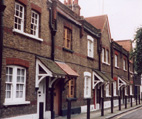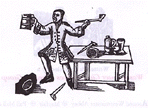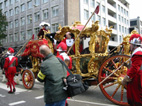Warning: reading
this page could seriously damage your eyesight or your bank
balance! Visitors are requested to support Red Nose Day by buying
Red Nose products or making a donation to Comic Relief. You can
visit the official site to find out how you can help by clicking
on any of the logos. Thanks.
RED BUSES
A prominent feature that has become a tourist icon. The
introduction of the omnibus in London is credited to
George Shilliber in 1829. In 1933 all buses were bought
under the control of London Transport. Since 1984 the
situation has reversed and routes have been put out to
tender, although buses running in Central London are
still required to be red. Routemasters were introduced around 1960
and are still doing sterling service. Their open platform
and conductor making them ideal for busy routes. The
newest buses are the so-called Bendy Buses with 3-door
entry. Bus travel is excellent value for money with a
one-day bus pass costing only £2 and it provides a
leisurely way of getting around (ie it's not so good if
you're in a hurry!). North of the Thames the number 11
passes major sites between Liverpool Street and Chelsea
and the new RV1 between Covent Garden and Tower Gateway
serves 47 attractions, many south of the river. The TfL website covers all aspects of travel by public
transport in London. To find out more about the history
aspect visit the LT Museum in Covent Garden (charge) or
log on to their website. |

|

|
CENTRAL LINE
The complexity of London's Underground system is
organised on the distinctive tube map, originally
designed by Henry C Beck in 1933 and based on circuit
diagrams. He received only 5 guineas for the design &
artwork although it has expanded with the system and been
produced millions of times in numerous formats. The
colour code has allocated red to the Central line. he Central line was
first built in 1900 between Bank and Shepherd's Bush and
extended between 1908 & 1949. It now runs between
Ealing Broadway or West Ruislip to Hainault or Epping,
covering a distance of 46 miles with 49 stations.
Originally it used shorter trains and slightly smaller
diameter tunnels but was standardised in 1938-40. During
WWII tunnels between Newbury Park and Wanstead were used
for the manufacture of aircraft parts. Between 1957 &
1994 there was a single track extension from Epping to
Ongar, which remains the start point for measurements of
the whole system. WHEN it is operational you can take the
longest continous journey between West Ruislip &
Epping - a distance of 34.1 miles which should take 1hr
28½ mins! You can view current information on the TfL website or investigate the history at the LT
Museum in Covent Garden (charge) or log on to their website. |
RED PIERS
Between the road and rail bridges at Blackfriars there
remain a line of cast iron colums that once supported the
London, Chatham & Dover Railway crossing built in
1862-4 by Joseph Cubitt and F T Turner. |

|

|
STOPPING AT RED
Stopping at red
lights is a common occurence in London these days but the
first traffic lights to be installed were at the NE of
Parliament Square and are recorded by a plaque on Bridge
Street. Motorists may be forgiven for thinking they are
seeing things at a Westferry roundabout where there is a
traffic light tree sculptured in steel by Pierre Vivant
in the 1990s.
Photo by Ray
Farrar |
Question: Do
you know why the church of St Sepulchre-without-Newgate has red
and blue railings? Answer at the end.
 |
TELEPHONE BOXES
Despite mobile phones a familiar site on London streets
are red telephone boxes. The K2s that
remain (with cut-out crown & regular windows - as
pictured) are listed 'buildings'. More information on
telephone boxes is available on the GLIAS website [click here]Comic Relief - registered charity 326568
|

|

|
PILLAR BOXES
Red was also the colour choice for
another piece of street furniture - the pillar box. I
have come across examples of 'Penfold Hexagonals' in
Chislehurst, Hampstead, Walthamstow, Bedford Park &
Bexley and there is an Edward VIII at the junction of
Southend Road & Brackley Road in Beckenham. Outside
the Royal Hospital Chelsea is a postbox with 2 slots so
that letters can be posted from both sides when the gates
are locked. In October 2002 the Post Office produced a
series of stamps to commemorate the 150th anniversary. A
presentation pack is available. More information on
pillar boxes is available on the GLIAS website [click here] |
 |
RED BRICK
During the building boom in the Victorian period
locally-made stock bricks were cheaper than red (because of transportation
costs) but were an unattractive grey/yellow colour. It
was therefore not unusual to build houses in London
stocks with string courses or other features in red brick or with red bricks only on the front
elevation. Red
bricks were favoured for buildings c1880s in the 'Queen
Anne' style prevalent in places like Bedford Park
(pictured left). |
 |
RED BUILDINGS
Alfred Waterhouse used red brick and terracotta for two large
projects - the Prudential in Holborn and the former
University College Hospital cruciform building in Gower
Street. This was generously funded by Sir John Blundell
Maple even when the projected costs doubled to £200000.
Westminster Cathedral was built between 1896-1903. Its
Byzantine style design in red brick by J F Bentley was chosen in
contrast to the stone of Westminster Abbey.
Another notable building which uses red bricks from Nottingham (60
million of them!) is the former Midland Grand Hotel/St
Pancras Station designed in Gothic style by Sir George
Gilbert Scott and built 1868-72. It was closed in 1935
and used as offices until the 1980s. In the 1990s the
exterior was restored and the building transferred to
London & Continental Railways who plan to redevelop
it as a hotel/apartments. The foyer and former coffee
lounge are open 11-3 Monday - Friday for viewing or tours
(charge) are available by arrangement.
The controversial British Library next door was also
constructed in red
brick. A reader's ticket is required to use the vast
collection but there are public areas with exhibitions,
shop, cafe & restaurant open daily. The building
which was designed by Professor Sir Colin St John Wilson
has a floor space of 100000 sqm, 300km of shelving and
1000 staff. Chargable tours are available. [website] |
 |
REDBRIDGE
A London borough formed from Ilford, Wanstead &
Woodford and named after the Old Red Bridge which crossed the River
Roding until 1922.
Find out more about the area on the websiteComic Relief - registered charity 326568
|
RED LION
SQUARE
Named after an inn where the disinterred bodies of Ireton,
Cromwell & Bradshaw were kept overnight in 1661. Number 17
was home to Rossetti and later Edward Burne-Jones & William
Morris. The firm of Morris & co was set up at number 8. There
is a blue plaque to John Harrison,
inventor of the marine chronometer, who lived & died in a
house in the square and a bronze bust of Philosopher &
Mathematicain, Bertrand Russell.
THE RED HOUSE
This house in Bexleyheath was commissioned by William
Morris and designed by Philip Webb. Completed in 1859 it
was the home of Morris and his wife Jane for 5 years
during which time their two daughters were born. It
became a base for artists and craftsmen, including
Burne-Jones & Rossetti who contributed to the
decorations and furnishings. Latterly the house was owned
and cared for by the Hollomby family, who bought it in
1952, with assistance from the Red House Trust and the Friends of Red House, both set up in the 1990s. It
has now run by the National Trust |
REDCROSS WAY
This is a street in SE1 with several features of
interest. Between Redcross Way and Ayres Street are
cottages and a garden planned by Octavia Hill on land
belonging to the Church Commissioners (similar cottages
pictured left).
To the NE of the junction with Union Street a map of 1872
shows St Saviour's National Schools and a builders yard.
This was previously the site of the Cross Bones Burying
Ground used by the parish of St Saviours between the
17thc and 1853. It was excavated and recorded by the
Museum of London in 1991-8 when the Jubilee line was
under construction. A history of the burial ground plus
results of the findings has been published [more info].
To the NW of the junction with Southwark Street are
Cromwell Buildings - Improved Industrial Dwellings of
1862 which owe their existance to Sir Sydney Waterlow,
stationer & Lord Mayor. |
 |
 |
RED FEATHER DAY
This is commemorated by pupils of Sir John Cass
Foundation School in February with a service at St
Botolphs Aldgate at which they wear red feathers. The
school was founded in Houndsditch in 1669. In 1710
Alderman Cass agreed to provide funds but died suddenly
before he could sign the deed (hence the bloodied feather
quill) and the school closed for 10 years in 1738 until
the deed was enforced. The primary school has occupied
premises in Dukes Place since 1909 and the secondary
school amalgamated with the Mile End Red Coat School, now in Stepney Way.Comic Relief - registered charity
326568
|
RED BULL
THEATRE
This was an open air playhouse built in 1600 which stood near
present day Hayward Place, Clerkenwell. It was used by the
Queen's Men until 1617 and gave illegal performances during the
Commonwealth. It was re-opened in 1660 but demolished by 1665.
Pepys was unimpressed by the play he saw there in 1661.
RED LION (& OTHER) PUBS
The most common pub name is the Red Lion - here are 3 London ones
you can try.
23 Crown Passage - tucked down an alleyway this is one of
London's oldest pubs.
2 Duke of York Street - noted for its brilliant cut and
acid-etched mirrors.
48 Parliament Street - the nearest to Downing Street and
with a division bell for MPs.
It was visited by Dickens as a child when he worked at
the Blacking factory, an incident he later used in 'David
Copperfield'. |
 |
A group from Westminster Archives have
produced a book 'One on Every Corner - a history of some
Westminster pubs'. Their research found Red Lion pubs in Waverton Street,
Russell Street, Union Street, Clarges Street, Old Pye
Street, Hop Gardens & Petty France in addition to
those mentioned above. There were Red Crosses in Curzon Street, Clarges
Street & Tothill Street; a Red Dragon in Arundel Street and a Red Horse in Old Bond Street.
Details of the
publication [click here] |

|
LORD MAYOR
In 1215 King John gave the City of London the right to
elect their own Chief Justice (Lord Mayor was a later
title) but he still had to appear before the king for
royal approval and swear loyalty to the crown. This was
the beginning of what was to become the Lord Mayor's Show. This takes place on the second Saturday
in November when the new Lord Mayor rides in an elaborate
gilded coach (normally kept at the Museum of London). The coachman's seat is draped in red cloth and pikemen in a red uniform walk alongside. Besides
his scarlet gown the mayor has one of
violet, plain black (for mourning) and black & gold
(worn on civic state occassions). The crimson velvet Reception Robe is worn
only in the presence of the sovereign and dates from the
reign of George IV. Should he attend a monarch's
coronation where he officiates as Chief Butler he would
be required to purchase a special robe costing several
thousands.Information
from the London Encylopoedia by Weinreb & Hibbert
|
WATERMEN
Until the 19th century the Thames was London's main
thoroughfare and 1000s of watermen in wherries provided
passenger transport. The use of watermen for state
occassions began in 1454 when the Lord Mayor took up his
duties using a specially constructed barge. An Act of
1555 to regulate the trade led to the formation of the
Waterman's Company. Their ceremonial dress includes a red hat and coat (see below).Comic Relief
- registered charity 326568
|

|
DOGGETT'S COAT & BADGE RACE
This is the oldest annual event in the British sporting
calendar and was instigated by Thomas Doggett, a comedian
and joint manager of the Drury Lane Theatre, who had
relied on the Watermen to carry him from his home in
Chelsea to his place of work, sometimes in poor weather
conditions. When he died in 1715 his will provided £5
for a silver badge, weighing 12oz and depicting the White
Horse of Hanover (to commemorate the ascession of George
I to the throne) together with a livery including a red coat with silver buttons. The
race is from London Bridge to Chelsea Pier, a distance of
4 miles 5 furlongs, and takes place in July against the
ebb tide. Originally the boats were skiffs but are now
light sculling boats which average a time of 30 minutes.
Men and women in their first year of freedom of the
Company of Watermen & Lightermen are eligible to
enter and from the 1990's unsuccessful entrants could row
again in their second and third years. The original
bequest no longer covers the cost of the prize which is
supplied by the Fishmongers who organise the event. There
is a pub named after the race at the south west of
Blackfriars Bridge. |

|
GUARDS
In times past much of the British Army was kitted out in redcoats but now its use is much more
limited. The 5 regiments of foot guards (Coldstream,
Grenadier, Welsh, Scots & Irish) wear red ceremonial tunics. They usually
form the guard at Buckingham Palace and a changing the
guard ceremony takes place 11:30 - 12:15 (on odd days in
February). Of the Household Cavalry the Life Guards wear red tunics, the Blues & Royals
blue. They usually form the guard at Horse Guards Parade
and a daily changing the guard ceremony takes place
11-11:30 (10-10:30 Sundays). The guards take part in the
Trooping the Colour ceremony in June [more info].
There is a Guards Museum in Wellington Barracks, Birdcage
Walk which is open daily (charge).
The history of the British Army is the subject of the National Army Museum in Chelsea. It is open daily and
offers free admission plus a programme of talks and
special events. |
CHELSEA PENSIONERS
The Royal Hospital Chelsea was founded in 1682 by Charles
II as a retreat for veterans of the regular army who had
become unfit for duty either after 20 years service or as
a result of wounds. The buildings, designed by Sir
Christopher Wren, are still home to some 400 pensioners
who receive board & lodging, uniform and nursing
care. Their everyday uniform is navy blue but they have a
red coat for ceremonial dress which
they also wear when acting as guides at the hospital. The
grounds are open to the public, as are the Chapel, Great
Hall and museum weekdays 10-12 & 2-4 (Sundays pm
seasonally). Visitors may also attend the Chapel services
on Sundays; Holy communion at 8:30am and Matins at 11am,
after the Governor's Parade at 10:40. There is no
specific admission charge. Souvenir items and guide books
are sold in the museum shop. |

|
Answer: The
church of St Sepulchre-without-Newgate has red & blue
railings because it is the church of the Royal Fusiliers













